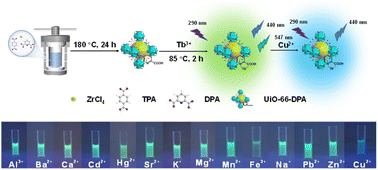Ratiometric detection of Cu2+ in water and drinks using Tb(iii)-functionalized UiO-66-type metal–organic frameworks†
Abstract
As an important trace element in the human body, the concentration of Cu2+ has an important impact on the environment and human health, and its quantitative determination is of great significance in the fields of environmental protection and food safety. Here, a ratiometric fluorescent probe based on Tb(III)-functionalized UiO-66-type MOFs has been synthesized via a facile post-synthetic modification method by employing mixed linkers containing terephthalic acid and 2,6-pyridinedicarboxylic acid for Cu2+ detection. The blue fluorescence intensity at 440 nm from the ligands of MOFs does not change much with increasing Cu2+ concentrations and can be used as a reference signal, while the green fluorescence of Tb3+ can be rapidly and selectively quenched, causing fluorescence intensity at 547 nm to decrease. The probe can be used as a ratiometric sensor for Cu2+ detection with a good linear response and low detection limit. The use of the probe for the determination of Cu2+ in real water samples and drinks shows good practicality. This method for Cu2+ detection is simple, specific and visualized to meet the needs of environmental monitoring and food analysis and provides a new strategy for the construction of new copper ion fluorescent sensors to analyze complex samples.

- This article is part of the themed collection: Analytical Methods HOT Articles 2023


 Please wait while we load your content...
Please wait while we load your content...